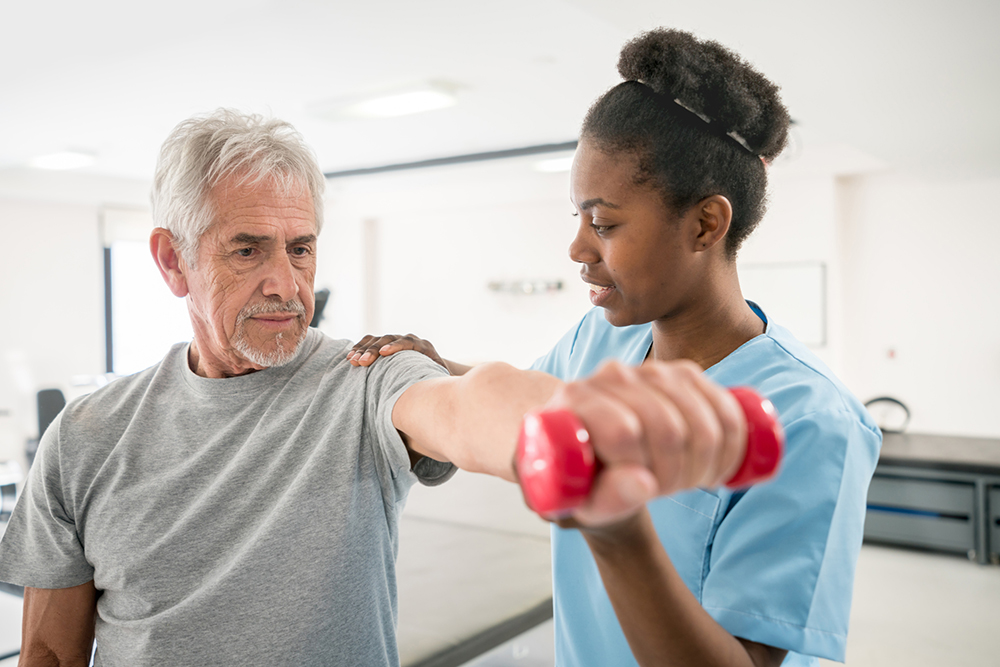Wednesday, March 6, 2024
Understanding Physical Therapy, Occupational Therapy and Speech-Language Pathology
Reviewed by Steve Albanese, PT, DPT, and Howard Wilen, MPT
Imagine struggling to walk after a knee injury, fumbling with everyday tasks after a stroke or finding it difficult to communicate due to a neurological condition. These are just a few examples of how injuries, illnesses and age-related changes can affect our ability to function independently and interact with the world around us.
Fortunately, physical therapists (PTs), occupational therapists (OTs) and speech-language pathologists (SLPs) are on your side.
While these professionals share the goal of helping you reclaim your independence and improve your quality of life, they each approach it through specialized lenses. Understanding their distinct roles can empower you to make informed decisions about your rehabilitation journey.

Physical Therapy: Reclaiming Movement and Function
Physical therapy focuses on restoring your body's movement abilities, including:
- Strength: Building muscle mass and improving endurance through targeted exercises
- Flexibility: Enhancing range of motion and reducing stiffness with stretching and movement techniques
- Balance and coordination: Improving stability and preventing falls through specialized exercises
- Pain management: Alleviating discomfort and promoting healing with modalities like heat and cold therapy
Occupational Therapy: Improving the World of Daily Activities
Occupational therapy helps you regain independence in performing the activities that make up your daily life, such as:
- Self-care tasks: Dressing, bathing, grooming and toileting
- Household chores: Cooking, cleaning, laundry and organizing
- Work and leisure activities: Engaging in hobbies, returning to work and participating in social activities
- Cognitive and sensory processing: Improving memory, focus and sensory integration for those with neurological conditions
- Motor skills: Specific focus on regaining optimal use of one’s upper extremities (hand, wrist and elbow) due to an injury or impairment
Speech-Language Pathology: Restoring Communication and Expression
Speech-language pathology focuses on preventing, assessing, diagnosing and treating communication and swallowing disorders. This can include:
- Speech sound disorders: Difficulty producing speech sounds correctly or fluently
- Language disorders: Difficulty understanding or using spoken language (e.g., aphasia after a stroke)
- Voice disorders: Problems with vocal quality, pitch or volume
- Swallowing disorders: Difficulty swallowing food or liquids safely
- Cognitive-communication disorders: Difficulty with communication due to cognitive impairments (e.g., dementia)
A Powerful Synergy: Working Together for Optimal Recovery
While PT, OT and SLP each have unique roles, their paths often intersect. A collaborative approach where these professionals work together allows for:
- More comprehensive care: Addressing physical limitations, challenges in daily living and communication difficulties
- Improved outcomes: Achieving faster and more sustainable progress towards your recovery goals
- Enhanced quality of life: Regaining independence, confidence and the ability to engage in meaningful communication and activities
Ready to Embark on Your Journey?
If you're seeking to reclaim your independence, improve your communication or enhance your overall well-being, our team is here to support you. Personalized assessments and treatment plans are tailored to your specific needs and goals.
Physical and rehabilitation medicine services are available to members of our community at WMCHealth facilities around the Hudson Valley.To find a rehabilitation medicine service convenient for you, please visit WMCHealth.org.